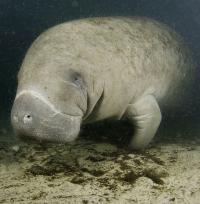 It wasn’t so long ago when the conversation regarding Florida manatees was not whether or not they would become extinct but rather how quickly their extinction would happen. Fortunately, efforts to save the manatee have paid off. In 1991, the Florida manatee population was down to 1,270. Current estimates by the U.S. Fish and Wildlife Service now put the population at around 6,300, an increase of almost 500%. Regulations to limit boat speed in areas frequented by manatees have been largely successful as have efforts to preserve winter habitats.
It wasn’t so long ago when the conversation regarding Florida manatees was not whether or not they would become extinct but rather how quickly their extinction would happen. Fortunately, efforts to save the manatee have paid off. In 1991, the Florida manatee population was down to 1,270. Current estimates by the U.S. Fish and Wildlife Service now put the population at around 6,300, an increase of almost 500%. Regulations to limit boat speed in areas frequented by manatees have been largely successful as have efforts to preserve winter habitats.
Because of the rebound in the population, the Fish and Wildlife Service has proposed reclassifying the manatee from endangered to threatened status under the Endangered Species Act (ESA). Many environmentalists consider the change to be premature. Even with the status change, manatees would still receive the same protection from the Marine Mammal Protection Act of 1972 and the Florida Manatee Sanctuary Act of 1978.
Despite the good news, water pollution continues to be a serious threat to the species. Between 2012 to 2015, 158 manatees died in Florida’s Indian River Lagoon on Florida’s East Coast. This year over a dozen manatee deaths have been reported in the polluted waterway. Repeated algae blooms have killed much of the eel grass that is the manatees’ primary source of food. The waterway has also proved deadly to dolphins and pelicans and even to humans. The deadly vibrio vulnificus bacteria has also been found in the Indian River Lagoon. Infections from the bacteria killed 36 people in Florida in 2016.
The worst of the algae blooms are largely attributed agricultural run-off. Fertilizers from sugar cane fields can cause huge blooms, which clog water ways, kill plants and fish and can sicken or kill people. In July we posted, Pogo and the Latest Florida Algae Bloom, about the most recent algae bloom in the area near the Indian River Lagoon.
